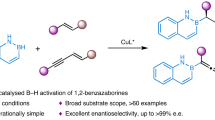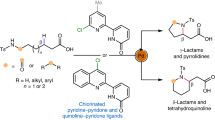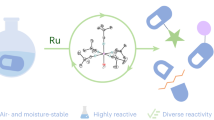Abstract
The direct reduction of inert planar arenes and heteroarenes with visible light remains rarely explored, as the energy of one visible-light photon is unable to overcome the stabilization of aromatics. Here we report a system based on boron carbonitride semiconductor, which can reduce arenes and heteroarenes in water under blue light irradiation. The system features the advantage of low-cost, high-efficiency, facile separation, benign environmental profile and broad substituent tolerance. The methodology can be extended to late-stage functionalization and/or deuteration of drugs, hormones and axially chiral compounds with conserved chirality. Moreover, gram-scale synthesis is successfully implemented with catalyst recycling. Mechanistic investigations support a consecutive blue-light-induced energy and electron transfer process, which accumulates sufficient energy to reduce arenes to arene anions by absorbing two photons successively. The metal-free system introduces a simple and sustainable reactivity mode for semiconductor photocatalysts and enriches the chemical toolkit for a class of demanding and valuable organic transformations.

This is a preview of subscription content, access via your institution
Access options
Access Nature and 54 other Nature Portfolio journals
Get Nature+, our best-value online-access subscription
$29.99 / 30 days
cancel any time
Subscribe to this journal
Receive 12 digital issues and online access to articles
$119.00 per year
only $9.92 per issue
Buy this article
- Purchase on Springer Link
- Instant access to full article PDF
Prices may be subject to local taxes which are calculated during checkout






Similar content being viewed by others
Data availability
The data generated in this study are provided in the article and the Supplementary Information file or are available from the corresponding author upon reasonable request. Atomic coordinates of the optimized computational models are provided in Supplementary Data 1. Source data are provided with this paper.
References
Wertjes, W. C., Southgate, E. H. & Sarlah, D. Recent advances in chemical dearomatization of nonactivated arenes. Chem. Soc. Rev. 47, 7996–8017 (2018).
Zimmerman, H. E. A mechanistic analysis of the Birch reduction. Acc. Chem. Res. 45, 164–170 (2012).
Burrows, J., Kamo, S. & Koide, K. Scalable Birch reduction with lithium and ethylenediamine in tetrahydrofuran. Science 374, 741–746 (2021).
Birch, A. J. The Birch reduction in organic synthesis. Pure Appl. Chem. 68, 553–556 (1996).
Hook, J. M. & Mander, L. N. Recent developments in the Birch reduction of aromatic-compounds—applications to the synthesis of natural products. Nat. Prod. Rep. 3, 35–85 (1986).
Benkeser, R. A., Robinson, R. E., Sauve, D. M. & Thomas, O. H. Reduction of organic compounds by lithium in low molecular weight amines. I. Selective reduction of aromatic hydrocarbons to monoolefins. J. Am. Chem. Soc. 77, 3230–3233 (1955).
Lei, P. et al. A practical and chemoselective ammonia-free Birch reduction. Org. Lett. 20, 3439–3442 (2018).
Nandi, P., Dye, J. L. & Jackson, J. E. Birch reductions at room temperature with alkali metals in silica gel (Na2K-SG(I). J. Org. Chem. 74, 5790–5792 (2009).
Costanzo, M. J., Patel, M. N., Petersen, K. A. & Vogt, P. F. Ammonia-free Birch reductions with sodium stabilized in silica gel, Na-SG(I). Tetrahedron Lett. 50, 5463–5466 (2009).
Szostak, M., Spain, M. & Procter, D. J. Determination of the effective redox potentials of SmI2, SmBr2, SmCl2, and their complexes with water by reduction of aromatic hydrocarbons. Reduction of anthracene and stilbene by samarium(II) iodide–water complex. J. Org. Chem. 79, 2522–2537 (2014).
Donohoe, T. J. & Thomas, R. E. The partial reduction of electron-deficient pyrroles: procedures describing both Birch (Li/NH3) and ammonia-free (Li/DBB) conditions. Nat. Protocols 2, 1888–1895 (2007).
Il Yoo, B., Kim, Y. J., You, Y., Yang, J. W. & Kim, S. W. Birch reduction of aromatic compounds by inorganic electride [Ca2N]·+e− in an alcoholic solvent: an analogue of solvated electrons. J. Org. Chem. 83, 13847–13853 (2018).
Urban, S., Beiring, B., Ortega, N., Paul, D. & Glorius, F. Asymmetric hydrogenation of thiophenes and benzothiophenes. J. Am. Chem. Soc. 134, 15241–15244 (2012).
Zhang, J. W., Chen, F., He, Y. M. & Fan, Q. H. Asymmetric ruthenium-catalyzed hydrogenation of 2,6-disubstituted 1,5-naphthyridines: access to chiral 1,5-diaza-cis-decalins. Angew. Chem. Int. Ed. 54, 4622–4625 (2015).
Kuwano, R., Sato, K., Kurokawa, T., Karube, D. & Ito, Y. Catalytic asymmetric hydrogenation of heteroaromatic compounds, indoles. J. Am. Chem. Soc. 122, 7614–7615 (2000).
Feiertag, P., Albert, M., Nettekoven, U. & Spindler, F. Asymmetric homogeneous hydrogenation of 2,5-disubstituted furans. Org. Lett. 8, 4133–4135 (2006).
Duan, Y. et al. Homogenous Pd-catalyzed asymmetric hydrogenation of unprotected indoles: scope and mechanistic studies. J. Am. Chem. Soc. 136, 7688–7700 (2014).
Chen, Z. P., Chen, M. W., Shi, L., Yu, C. B. & Zhou, Y. G. Pd-catalyzed asymmetric hydrogenation of fluorinated aromatic pyrazol-5-ols via capture of active tautomers. Chem. Sci. 6, 3415–3419 (2015).
Kuwano, R., Hashiguchi, Y., Ikeda, R. & Ishizuka, K. Catalytic asymmetric hydrogenation of pyrimidines. Angew. Chem. Int. Ed. 54, 2393–2396 (2015).
Chang, M. X. et al. Asymmetric hydrogenation of pyridinium salts with an iridium phosphole catalyst. Angew. Chem. Int. Ed. 53, 12761–12764 (2014).
Giustra, Z. X., Ishibashi, J. S. A. & Liu, S. Y. Homogeneous metal catalysis for conversion between aromatic and saturated compounds. Coord. Chem. Rev. 314, 134–181 (2016).
Peters, B. K. et al. Scalable and safe synthetic organic electroreduction inspired by Li-ion battery chemistry. Science 363, 838–845 (2019).
Romero, N. A. & Nicewicz, D. A. Organic photoredox catalysis. Chem. Rev. 116, 10075–10166 (2016).
Marzo, L., Pagire, S. K., Reiser, O. & Kӧnig, B. Visible-light photocatalysis: does it make a difference in organic synthesis? Angew. Chem. Int. Ed. 57, 10034–10072 (2018).
Huang, H. et al. Visible-light-driven anti-Markovnikov hydrocarboxylation of acrylates and styrenes with CO2. CCS Chem. 3, 1746–1756 (2021).
Zhou, C. et al. Metal-free, redox-neutral, site-selective access to heteroarylamine via direct radical–radical cross-coupling powered by visible light photocatalysis. J. Am. Chem. Soc. 142, 16805–16813 (2020).
Luo, Z. S. et al. Unveiling the charge transfer dynamics steered by built-in electric fields in BiOBr photocatalysts. Nat. Commun. 13, 2230 (2022).
McCallum, T., Pitre, S. P., Morin, M., Scaiano, J. C. & Barriault, L. The photochemical alkylation and reduction of heteroarenes. Chem. Sci. 8, 7412–7418 (2017).
Glaser, F., Kerzig, C. & Wenger, O. S. Multi-photon excitation in photoredox catalysis: concepts, applications, methods. Angew. Chem. Int. Ed. 59, 10266–10284 (2020).
Giedyk, M. et al. Photocatalytic activation of alkyl chlorides by assembly-promoted single electron transfer in microheterogeneous solutions. Nat. Catal. 3, 40–47 (2020).
Zeman, C. J., Kim, S., Zhang, F. & Schanze, K. S. Direct observation of the reduction of aryl halides by a photoexcited perylene diimide radical anion. J. Am. Chem. Soc. 142, 2204–2207 (2020).
Xu, J. H. et al. Unveiling extreme photoreduction potentials of donor–acceptor cyanoarenes to access aryl radicals from aryl chlorides. J. Am. Chem. Soc. 143, 13266–13273 (2021).
Cole, J. P. et al. Organocatalyzed Birch reduction driven by visible light. J. Am. Chem. Soc. 142, 13573–13581 (2020).
Chatterjee, A. & Kӧnig, B. Birch-type photoreduction of arenes and heteroarenes by sensitized electron transfer. Angew. Chem. Int. Ed. 58, 14289–14294 (2019).
Huang, C. J. et al. Carbon-doped BN nanosheets for metal-free photoredox catalysis. Nat. Commun. 6, 7698 (2015).
Luo, Z. S., Fang, Y. X., Zhou, M. & Wang, X. C. A borocarbonitride ceramic aerogel for photoredox catalysis. Angew. Chem. Int. Ed. 58, 6033–6037 (2019).
Fang, Y. X. et al. Vertically aligned 2D carbon doped boron nitride nanofilms for photoelectrochemical water oxidation. J. Mater. Chem. A 8, 13059–13064 (2020).
Hao, Y. Z., Wang, S. Z., Shao, Y. L., Wu, Y. Z. & Miao, S. D. High-energy density Li-ion capacitor with layered SnS2/reduced graphene oxide anode and BCN nanosheet cathode. Adv. Energy Mater. 10, 1902836 (2020).
Zhang, L. et al. Tailoring the defects of two-dimensional borocarbonitride nanomesh for high energy density micro-supercapacitor. Energy Storage Mater. 42, 430–437 (2021).
Zheng, M. F., Cai, W. C., Fang, Y. X. & Wang, X. C. Nanoscale boron carbonitride semiconductors for photoredox catalysis. Nanoscale 12, 3593–3604 (2020).
Fang, Y. X. & Wang, X. C. Metal-free boron-containing heterogeneous catalysts. Angew. Chem. Int. Ed. 56, 15506–15518 (2017).
Zhang, X. F. et al. Methanol conversion on borocarbonitride catalysts: identification and quantification of active sites. Sci. Adv. 6, eaba5778 (2020).
Guo, F. S. et al. Carbon-doped BN nanosheets for the oxidative dehydrogenation of ethylbenzene. Angew. Chem. Int. Ed. 56, 8231–8235 (2017).
Zheng, M. F., Shi, J. L., Yuan, T. & Wang, X. C. Metal-free dehydrogenation of N-heterocycles by ternary h-BCN nanosheets with visible light. Angew. Chem. Int. Ed. 57, 5487–5491 (2018).
Shi, J. L., Yuan, T., Zheng, M. F. & Wang, X. C. Metal-free heterogeneous semiconductor for visible-light photocatalytic decarboxylation of carboxylic acids. ACS Catal. 11, 3040–3047 (2021).
Yuan, T., Zheng, M. F., Antonietti, M. & Wang, X. C. Ceramic boron carbonitrides for unlocking organic halides with visible light. Chem. Sci. 12, 6323–6332 (2021).
Yuan, T. et al. Semi-hydrogenation of alkynes by a tandem photoredox system free of noble metal. CCS Chem. 4, 2597–2603 (2022).
Wang, H. et al. Enhanced singlet oxygen generation in oxidized graphitic carbon nitride for organic synthesis. Adv. Mater. 28, 6940–6945 (2016).
Chakraborty, S., Brennessel, W. W. & Jones, W. D. A molecular iron catalyst for the acceptorless dehydrogenation and hydrogenation of N-heterocycles. J. Am. Chem. Soc. 136, 8564–8567 (2014).
Zhao, D. B. & Glorius, F. Enantioselective hydrogenation of isoquinolines. Angew. Chem. Int. Ed. 52, 9616–9618 (2013).
Ye, Z. S. et al. Enantioselective iridium-catalyzed hydrogenation of 1- and 3-substituted isoquinolinium salts. Angew. Chem. Int. Ed. 52, 3685–3689 (2013).
Wen, J. L., Tan, R. C., Liu, S. D., Zhao, Q. Y. & Zhang, X. M. Strong Brønsted acid promoted asymmetric hydrogenation of isoquinolines and quinolines catalyzed by a Rh–thiourea chiral phosphine complex via anion binding. Chem. Sci. 7, 3047–3051 (2016).
Islangulov, R. R. & Castellano, F. N. Photochemical upconversion: anthracene dimerization sensitized to visible light by a Ru-II chromophore. Angew. Chem. Int. Ed. 45, 5957–5959 (2006).
Das, S. et al. Photocatalytic (het)arylation of C(sp3)–H bonds with carbon nitride. ACS Catal. 11, 1593–1603 (2021).
Savateev, A. et al. Potassium poly(heptazine imide): transition metal-free solid-state triplet sensitizer in cascade energy transfer and [3+2]-cycloadditions. Angew. Chem. Int. Ed. 59, 15061–15068 (2020).
Liu, X. F. et al. Facile synthetic strategy for efficient and multi-color fluorescent BCNO nanocrystals. Chem. Commun. 21, 4073–4075 (2009).
Liu, X. F. et al. BCNO-based long-persistent phosphor. J. Electrochem. Soc. 156, 81–84 (2009).
Liu, X. F. et al. Spectroscopic investigation on BCNO-based phosphor: photoluminescence and long persistent phosphorescence. J. Phys. D 42, 215409 (2009).
Kolodiazhnyi, T. & Golberg, D. Paramagnetic defects in boron nitride nanostructures. Chem. Phys. Lett. 413, 47–51 (2005).
Acknowledgements
This work was financially supported by the National Key Technologies R & D Program of China (2018YFA0209301, X.W.), the National Natural Science Foundation of China (22071026, M.Z.; U1905214, X.W.; 22032002, X.W.; 21961142019, X.W. and 21973014, W.L.), the Chang Jiang Scholars Program of China (T2016147, X.W.) and the 111 Project (D16008, X.W.).
Author information
Authors and Affiliations
Contributions
X.W. and M.Z. conceived and directed the project. T.Y. and M.Z. designed the experiments. T.Y., L.S., Z.W. and R.W. performed and analysed the experiments. X.C. and W.L. carried out the density functional theory calculations. T.Y., M.Z. and X.W. prepared the manuscript. All the authors contributed to the analysis and interpretation of the data and commented on the final draft of the manuscript.
Corresponding authors
Ethics declarations
Competing interests
The authors declare no competing interests.
Peer review
Peer review information
Nature Catalysis thanks Pei Yuin Keng, Jie An and the other, anonymous, reviewer(s) for their contribution to the peer review of this work.
Additional information
Publisher’s note Springer Nature remains neutral with regard to jurisdictional claims in published maps and institutional affiliations.
Supplementary information
Supplementary Information
Supplementary Methods, Notes 1–3, Figs. 1–33, Tables 1–8 and references.
Supplementary Data
Atomic coordinates of the optimized computational models.
Source data
Source Data Fig. 2
SEM, TEM and EELS mapping images, XRD pattern and high-resolution XPS spectra.
Source Data Fig. 3
Activity, AQE, UV-Vis DRS and FTIR spectra.
Source Data Fig. 4
Mott-Schottky plots, UV-Vis absorption, steady-state fluorescence, phosphorescence (PH), time-resolved PH decay, photocurrent and EPR spectra. Activity with different irradiation density of light.
Rights and permissions
Springer Nature or its licensor (e.g. a society or other partner) holds exclusive rights to this article under a publishing agreement with the author(s) or other rightsholder(s); author self-archiving of the accepted manuscript version of this article is solely governed by the terms of such publishing agreement and applicable law.
About this article
Cite this article
Yuan, T., Sun, L., Wu, Z. et al. Mild and metal-free Birch-type hydrogenation of (hetero)arenes with boron carbonitride in water. Nat Catal 5, 1157–1168 (2022). https://doi.org/10.1038/s41929-022-00886-0
Received:
Accepted:
Published:
Issue Date:
DOI: https://doi.org/10.1038/s41929-022-00886-0



